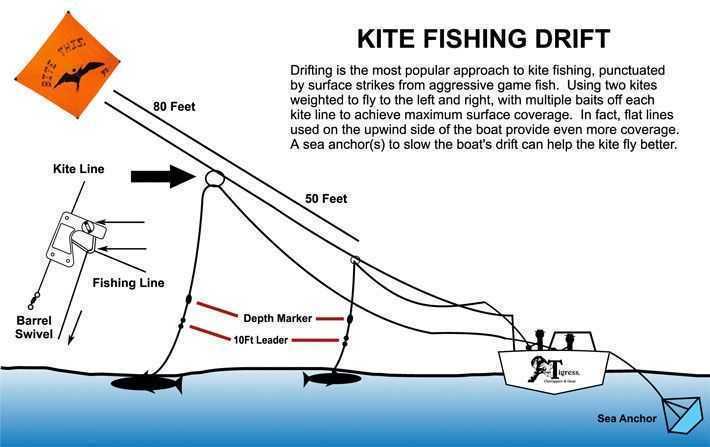Many different styles of fishing have originated in the hopes of catching sailfish and other pelagics. Perhaps the most effective of these types of fishing is kite fishing. Kite Fishing is a technique of fishing that involves flying kites in order to suspend live baits on the top of the water. This type of fishing is highly effective for sport fishing off the Atlantic coast, where the Gulf Stream current and the natural reef running along the coastline, coincide. Sport fishing charter boats have been using this technique for 20 years to hook into the wide array of big game species that swim through our waters. This article is written in order to teach basic tactics on how to go about kite fishing.
For kite fishing, live bait is required. The best and hardiest baitfish include goggle eyes (probably the most effective bait for this type of fishing), tinker mackerels, blue runners, pilchards, mullet, sardines and threadfin herring. When kite fishing, you are mostly immobile. You will drift whichever way the current is moving, but you can make small corrections with your engines. So first thing is to select a good area or depth of water to fish. Off the shore of Fort Lauderdale, one of the best areas is the 90’-120’ natural reef that runs along its coast. Other good areas are where there is a rip current, a temperature gradient, a color change or over the top of an artificial reef, such as a shipwreck. These are all good areas to begin fishing, and bear in mind that winds and currents will push you around a bit, so plan ahead.

Gauge the wind and choose the appropriate kite for your conditions that day. The wind rating for the kite should be listed in its manual. Launch your kite from the highest point you can on your boat. If you are going to fly 2 kites simultaneously, you will want to put a small lead on the lower corners of each kite, depending on which direction you want each kite to spread to. The weight for this should be about 1/8 ounce for light kites and about ½ ounce for heavy kites. If weighted properly, the kites should spread apart from each other enough so that when the baits are out, the baits cannot get tangled together.
Your kites are flying now, and are about 50’-75’ off the back of your boat. Along your kite line, you should have a small barrel swivel tied every 50’ or so feet along your kite line. Use a snap swivel and attach your first kite clip to the kite line. Set the pressure of the clip release by tightening or loosening the setscrew on the clip. You want the clip to release with slightly more pressure than the baitfish will exert.
Now it’s time to rig the baits. I like to sew my baits on with a wax line bridle. This gives you the most possible hook exposure and increases your hookup chances. Use a needle and sew the bait through the back of its neck, just behind the head of the fish. Don’t go too deep. About 1/4 of the baitfish’s body is as far as you want to stick that needle. Catch the loop of the wax line bridal on both sides with the hook and twist it up. Then stick the hook back underneath the entire bridal, making the hook tight to the body of the baitfish. Basically, the fish will be angled with his head up when he is dangling, forcing the baitfish to struggle to keep his head below water so he can breathe. This will cause a lot of vibrations which is the desired effect when kite fishing.
OK, the baitfish is ready to launch. Run the leader through the clip and begin to free spool the kite rod and fishing rod simultaneously. Once the bait is the desired distance from the boat, you must make adjustments to keep the bait right on the top of the water, struggling. The bait should be under the water, but the hook, leader and fishing line should all be out of the water. A lot of captains put a colored ribbon on the snap swivel of the fishing line, which is about 8’ out of the water, just above the bait. This helps visibility if there is a glare and the bait can’t be found at a quick glance.
When the fish strikes you may see a visual indication like a swatting bill, exposed fin, surface boil or splash. Wait for the bite and free spool the fishing reel and let the fish eat the bait. When the fish begins to peel line quickly lock up and begin to wind up the slack out of the line. When you come tight, the line will pop out of the pressure release clip and there will be slacker to take up. Keep winding until you come tight on the fish. When you come tight, set the hook with a couple gentle but firm tugs with the rod.
Kite fishing is a very exciting and effective because you get to see the whole bite sequence and the hook up ratio is usually very high. It takes quite a bit of practice to become proficient with kite fishing technique. Keep trying though.